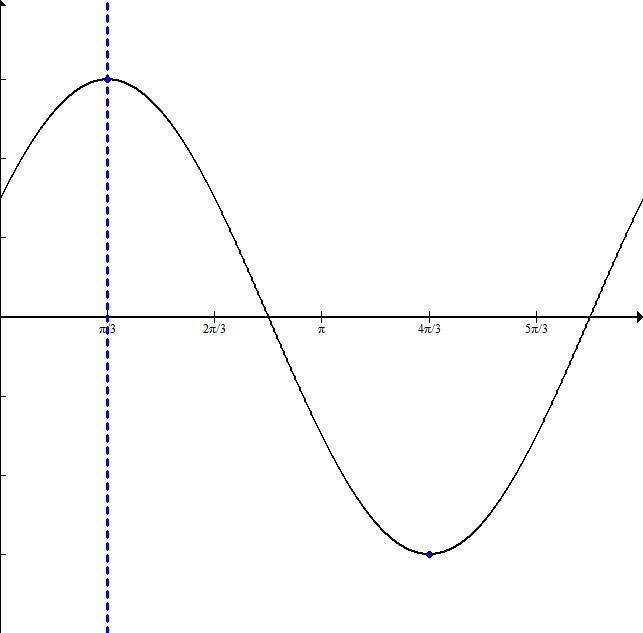Amplitude, Period, Phase Shift of a Trig Function
Help Questions
Pre-Calculus › Amplitude, Period, Phase Shift of a Trig Function
Which of the following equations could represent a cosine function with amplitude 3, period 

Explanation
The form of the equation will be
First, think about all possible values of A that could give you an amplitude of 3. Either A = -3 or A = 3 could each produce amplitude = 3. Be sure to look for answer choices that satisfy either of these.
Secondly, we know that the period is 

Finally, we need to find a value of C that satisfies


Next, plug in B= 4 to solve for C:
Putting this all together, the equation could either be:

Write the equation for a cosine graph with a maximum at 

Explanation
In order to write this equation, it is helpful to sketch a graph:

The dotted line is at 

The distance from the maximum to the minimum is half the entire wavelength. Here it is 
Since half the wavelength is 

The amplitude is 3 because the graph goes symmetrically from -3 to 3.
The equation will be in the form 
This equation is

Find the phase shift of 
-4
-2
2
3
Explanation
In the formula,


Plugging in what we know gives us:

Simplified, the phase is then 
What is the amplitude of the following function?
-24
-14
14
24
Explanation
When you think of a trigonometric function of the form y=Asin(Bx+C)+D, the amplitude is represented by A, or the coefficient in front of the sine function. While this number is -24, we always represent amplitude as a positive number, by taking the absolute value of it. Therefore, the amplitude of this function is 24.
What is the period of this sine graph?

Explanation
The graph has 3 waves between 0 and 


Which equation would produce this sine graph?
Explanation
The graph has an amplitude of 2 but has been shifted down 1:
In terms of the equation, this puts a 2 in front of sin, and -1 at the end.
This makes it easier to see that the graph starts \[is at 0\] where 
The phase shift is 

State the amplitude, period, phase shift, and vertical shift of the function
Amplitude: 7
Period: -
Phase Shift: -
Vertical Shift: -4
Amplitude: 7
Period: 
Phase Shift: 
Vertical Shift: -4
Amplitude: 7
Period: 
Phase Shift: -
Vertical Shift: -4
Amplitude: -7
Period: 
Phase Shift: -
Vertical Shift: 4
Explanation
A common way to make sense of all of the transformations that can happen to a trigonometric function is the following. For the equations y = A sin(Bx + C) + D,
- amplitude is |A|
- period is 2
/|B|
- phase shift is - C/B
- vertical shift is D
In our equation, A=-7, B=6, C=
To find amplitude, look at the coefficient in front of the sine function. A=-7, so our amplitude is equal to 7.
The period is 2


To find the phase shift, take -C/B, or -
6x+
6x=-
x=-
Either way, our phase shift is equal to -
The vertical shift is equal to D, which is -4.
y=-7\sin(6x+\pi)-4
State the amplitude, period, phase shift, and vertical shift of the function
Amplitude: 1
Period:
Phase Shift:
Vertical Shift: 3
Amplitude: 1
Period:
Phase Shift:
Vertical Shift: 3
Amplitude: 1
Period:
Phase Shift:
Vertical Shift: 0
Amplitude: 1
Period:
Phase Shift:
Vertical Shift: 3
Amplitude: 1
Period:
Phase Shift:
Vertical Shift: 3
Explanation
A common way to make sense of all of the transformations that can happen to a trigonometric function is the following. For the equations y = A sin(Bx + C) + D,
- amplitude is |A|
- period is 2
/|B|
- phase shift is - C/B
- vertical shift is D
In our equation, A=-1, B=1, C=-
To find amplitude, look at the coefficient in front of the sine function. A=-1, so our amplitude is equal to 1.
The period is 2

To find the phase shift, take -C/B, or 
x-
x=
Either way, our phase shift is equal to 
The vertical shift is equal to D, which is 3.
State the amplitude, period, phase shift, and vertical shift of the function
Amplitude: 1
Period:
Phase Shift: -3/2
Vertical Shift: -2
Amplitude: 1
Period:
Phase Shift: -3/2
Vertical Shift: 2
Amplitude: 1
Period: 3/2
Phase Shift:
Vertical Shift: 2
Amplitude: 1
Period:
Phase Shift: 3/2
Vertical Shift: 2
Explanation
A common way to make sense of all of the transformations that can happen to a trigonometric function is the following. For the equations y = A sin(Bx + C) + D,
- amplitude is |A|
- period is 2
/|B|
- phase shift is - C/B
- vertical shift is D
In our equation, A=1, B=2, C=-3, and D=2. Next, apply the above numbers to find amplitude, period, phase shift, and vertical shift.
To find amplitude, look at the coefficient in front of the sine function. A=1, so our amplitude is equal to 1.
The period is 2

To find the phase shift, take -C/B, or 3/2. Another way to find this same value is to set the inside of the parenthesis equal to 0, then solve for x.
2x-3=0
2x=3
x=3/2
Either way, our phase shift is equal to 3/2.
The vertical shift is equal to D, which is 2.
Select the answer choice that correctly matches each function to its period.
Explanation
The following matches the correct period with its corresponding trig function:
In other words, sin x, cos x, sec x, and csc x all repeat themselves every 





























 /|B|
/|B|




















































